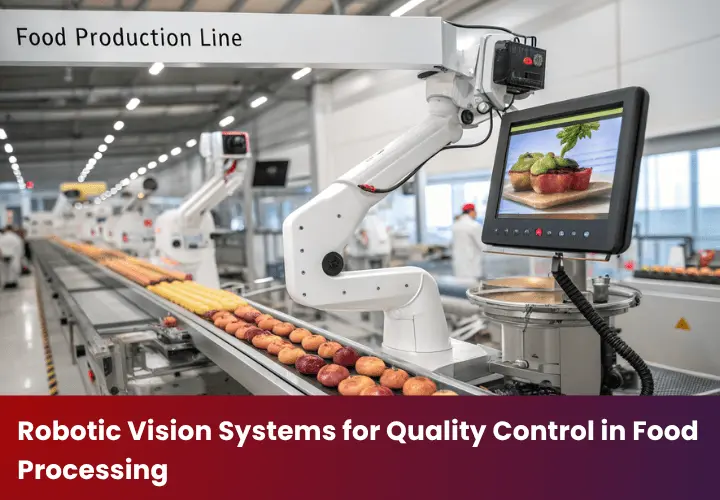
In today’s robotics in food industry, where customer expectations are sky-high and safety regulations are stricter than ever, one tiny error in food quality can lead to major consequences. From packaging recalls to brand reputation damage, poor quality control isn’t just inconvenient—it’s expensive.
That’s why robotic vision systems are rapidly transforming how food manufacturers monitor quality on their production lines. These intelligent, camera-powered robots are not only spotting what the human eye might miss—they’re doing it faster, more accurately, and without fatigue.
Let’s dive deep into how machine vision is helping food manufacturers achieve perfect consistency, better compliance, and near-zero defects.
What Are Robotic Vision Systems?
Robotic vision systems use high-resolution cameras, sensors, and AI-based software to simulate human vision—but with superhuman speed and precision. In food processing, these systems are mounted on robotic arms or above conveyors, scanning food items in real time.
They can:
-
Measure shape and size
-
Detect surface defects (like bruises or burns)
-
Identify discolouration or mould
-
Confirm correct packaging
-
Verify label presence and alignment
Once an issue is detected, the robot can automatically reject the defective item or alert operators instantly, avoiding product waste, recalls, and downtime.
How Machine Vision Identifies Defects in Food Items
Let’s break down the main inspection types that robotic vision handles:
1. Surface Defect Detection
Machine vision can detect flaws like:
-
Cracks on biscuits
-
Burn marks on baked goods
-
Bruising on fruits
-
Pinholes or air pockets in processed cheese
Using infrared imaging or hyperspectral cameras, even internal or sub-surface defects can be spotted without damaging the product.
2. Colour Inspection for Ripeness and Consistency
Colour is critical in food presentation and ripeness. Vision systems measure RGB color values to:
-
Confirm tomato ripeness
-
Detect undercooked or over-fried items
-
Spot yellowing or greening in leafy vegetables
-
Maintain brand consistency in processed foods like chips, sauces, or juices
AI algorithms learn the colour profiles of acceptable products and flag anything that deviates, even slightly.
3. Shape and Size Verification
In foods where uniformity matters—like burger patties, cookies, or chicken nuggets—machine vision systems check:
-
Dimensions (length, width, thickness)
-
Geometric shape
-
Volume and fill levels
This ensures every unit meets customer expectations and packaging requirements.
Why Robotic Vision Beats Human Inspection
Human inspectors can get tired, distracted, or inconsistent across shifts. Robotic vision, on the other hand, offers:
- 24/7 operation without fatigue
- High-speed inspection—up to hundreds of items per minute
- Repeatable accuracy at the micron level
- Real-time rejection with robotic arms or air jets
- Data collection for traceability and audits
When paired with AI and deep learning, these systems even improve over time, learning from mistakes and optimising detection patterns.
Real-World Use Cases in the Food Industry
Here are some practical applications of robotic vision in action:
-
Fruit Sorting: Apples and mangoes are scanned for bruising and irregular colour; defective ones are automatically diverted.
-
Meat Processing: Fat-to-lean ratio and marbling levels measured for grading and labelling.
-
Snack Foods: Chips are analysed for burn spots, size uniformity, and coating consistency.
-
Beverage Bottling: Vision systems check for fill levels, cap alignment, and label placement.
-
Frozen Foods: IQF (Individually Quick Frozen) vegetables are inspected mid-process, even under frost or condensation.
The Business Benefits
Investing in robotic vision for quality control offers:
-
Reduced labour costs
-
Fewer product recalls
-
Regulatory compliance (FDA, FSSAI, BRC, etc.)
-
Improved product consistency
-
Data-driven process optimisation
The ROI is often realised within months, especially in high-throughput food processing environments.
Choosing the Right Vision System
When selecting a robotic vision solution, consider:
-
Lighting (infrared, backlighting, UV)
-
Speed of your production line
-
Types of products being inspected
-
Integration with robotic arms or conveyors
-
Ability to train AI models for unique defects
At Delta Stark Engineering, we specialise in custom robotic vision solutions for the food industry—designed for Indian manufacturing conditions and tailored to your specific process.
1. Emerging Trends in Food Robotics
-
Collaborative robots (cobots) for safe human-machine interaction
-
Use of edge AI in on-site food inspection
-
Cloud-integrated vision systems for real-time analytics
-
3D vision technology for complex food geometries
2. Robotic Vision vs Traditional Sensors
| Feature | Robotic Vision | Traditional Sensors |
|---|---|---|
| Accuracy | High (micron-level) | Medium |
| Defect Detection | Surface + Subsurface | Mostly Surface |
| Adaptability | AI-driven, learns over time | Fixed thresholds |
| Integration | Easy with AI/ML systems | Needs manual calibration |
3. Challenges in Implementing Robotic Vision in the Indian Food Industry
-
High humidity and dust in factories
-
Variable lighting conditions
-
Diverse product shapes, sizes, and packaging
-
Budget constraints for smaller manufacturers
Solution: Modular and scalable vision systems like those offered by Delta Stark.
4. Government & Regulatory Push Toward Automation
-
FSSAI’s emphasis on quality traceability
-
Incentives under “Make in India” for automation tech
-
ISO/FSSC certifications encouraging automated QC systems
5. Sustainability Benefits of Robotic Vision
-
Reduces food waste by rejecting only truly defective units
-
Energy-efficient vs manual re-inspection processes
-
Enables lean manufacturing with minimal overproduction
6. Integration with ERP & MES Systems
-
Real-time defect logs can be pushed to ERP dashboards
-
Instant quality alerts for supervisors via MES
-
Enables predictive maintenance through analytics
Conclusion
Quality control in food isn’t optional—it’s a competitive advantage. With robotic vision systems, food processors can ensure every item that leaves the facility meets the highest standards, every single time.
Want to explore how robotic vision could work for your production line? Contact Delta Stark Engineering today for a free automation consultation.
